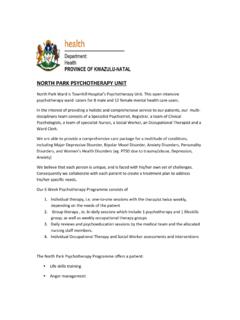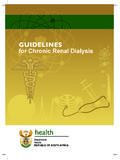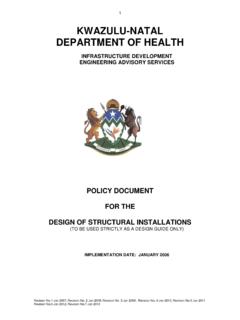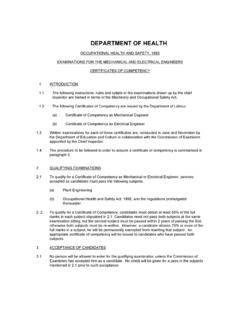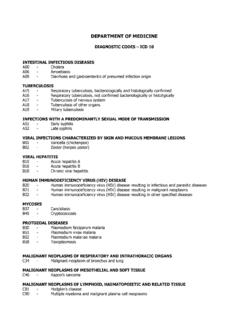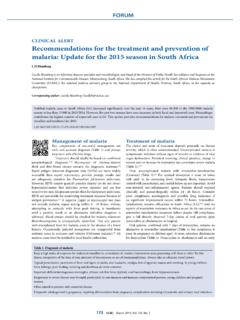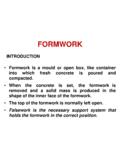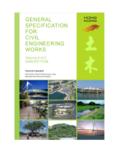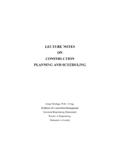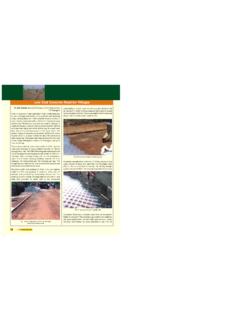Transcription of GOVERNMENT NOTICE DEPARTMENT OF LABOUR
1 GOVERNMENT NOTICE DEPARTMENT OF LABOUR No. R.. 2003 OCCUPATIONAL HEALTH AND SAFETY ACT, 1993 CONSTRUCTION REGULATIONS, 2003 The Minister of LABOUR has under section 43 of the Occupational Health and Safety Act, 1993 (Act No. 85 of 1993), after consultation with the Advisory Council for Occupational Health and Safety, made the regulations in the Schedule. SCHEDULE Definitions 1. In these Regulations any word or expression to which a meaning has been assigned in the Act shall have the meaning so assigned and, unless the context otherwise indicates agent means any person who acts as a representative for a client in the managing the overall construction work. angle of repose means the steepest angle of a surface at which a mass of loose or fragmented material will remain stationary in a pile on a surface, rather than sliding or crumbling away; batch plant means machinery, appliances or other similar devices that are assembled in such a manner so as to be able to mix materials in bulk for the purposes of using the mixed product for construction work; client means any person for whom construction work is performed; competent person in relation to construction work, means any person having the knowledge, training and experience specific to the work or task being performed: Provided that where appropriate qualifications and training are registered in terms of the provisions of the South African Qualifications Authority Act, 1995 (Act No.)
2 58 of 1995), these qualifications and training shall be deemed to be the required qualifications and training; construction work means any work in connection with (a) the erection, maintenance, alteration, renovation, repair, demolition or dismantling of or addition to a building or any similar structure; (b) the installation, erection, dismantling or maintenance of a fixed plant where such work includes the risk of a person falling; (c) the construction, maintenance, demolition or dismantling of any bridge, dam, canal, road, railway, runway, sewer or water reticulation system or any similar civil engineering structure; or (d) the moving of earth, clearing of land, the making of an excavation, piling, or any similar type of work; construction vehicle means a vehicle used for means of conveyance for transporting persons or material or both such persons and material, as the case may be, both on and off the construction site for the purposes of performing construction work; contractor means an employer, as defined in section 1 of the Act, who performs construction work and includes principal contractors; design in relation to any structure includes drawings, calculations, design details and specifications; designer means any person who (a) prepares a design; (b) checks and approves a design; (c) arranges for any person at work under his control (including an employee of his, where he is the employer) to prepare a design, as well as; (d) architects and engineers contributing to, or having overall responsibility for the design.
3 (e) build services engineers designing details for fixed plant; (f) surveyors specifying articles or drawing up specifications; (g) contractors carrying out design work as part of a design and build project; (h) temporary works engineer designing formwork and false work; and (i) interior designers, shop-fitters and landscape architects. ergonomics means the application of scientific information concerning humans to the design of objects, systems and the environment for human use in order to optimise human well-being and overall system performance; excavation work means the making of any man-made cavity, trench, pit or depression formed by cutting, digging or scooping; explosive powered tool means a tool that is activated by an explosive charge and that is used for driving bolts, nails and similar objects for the purpose of providing fixing; fall prevention equipment means equipment used to prevent persons from falling from an elevated position, including personal equipment, body harness, body belts, lanyards, lifelines or physical equipment, guardrails, screens, barricades, anchorages or similar equipment.
4 Fall arrest equipment means equipment used to arrest the person in a fall from an elevated position, including personal equipment, body harness, lanyards, deceleration devices, lifelines or similar equipment, but excludes body belts; fall protection plan means a documented plan, of all risks relating to working from an elevated position, considering the nature of work undertaken, and setting out the procedures and methods to be applied in order to eliminate the risk; hazard identification means the identification and documenting of existing or expected hazards to the health and safety of persons, which are normally associated with the type of construction work being executed or to be executed; health and safety file means a file, or other record in permanent form, containing the information required as contemplated in these regulations; health and safety plan means a documented plan which addresses hazards identified and includes safe work procedures to mitigate, reduce or control the hazards identified; health and safety specification means a documented specification of all health and safety requirements pertaining to the associated works on a construction site, so as to ensure the health and safety of persons; material hoist means a hoist used to lower or raise material and equipment, and includes cantilevered platform hoists, mobile hoists, friction drive hoists, scaffold hoists, rack and pinion hoists and combination hoists.
5 Medical certificate of fitness means a certificate valid for one year issued by an occupational health practitioner, issued in terms of these regulations, whom shall be registered with the Health Professions Council of South Africa; method statement means a written document detailing the key activities to be performed in order to reduce as reasonably as practicable the hazards identified in any risk assessment; mobile plant means machinery, appliances or other similar devices that is able to move independently, for the purpose of performing construction work on the construction site; National Building Regulations" means the National Building Regulations made under section 17(1) of the National Building Regulations and Building Standards Act, 1977 (Act of 1977), and published under GOVERNMENT NOTICE No. of 10 June 1988, as amended; person day means one individual carrying out construction work on a construction site for one normal working shift; principal contractor means an employer, as defined in section 1 of the Act who performs construction work and is appointed by the client to be in overall control and management of a part of or the whole of a construction site; professional engineer or professional certificated engineer means any person holding registration as either a Professional Engineer or Professional Certificated Engineer under the Engineering Profession Act, 2000 (Act No.)
6 46 of 2000); professional technologist means any person holding registration as a Professional Technologist under the Engineering Profession Act, 2000 ( Act No. 46 of 2000); provincial director means the provincial director as defined in regulation 1 of the General Adminstrative Regulations under the Act; risk assessment means a programme to determine any risk associated with any hazard at a construction site , in order to identify the steps needed to be taken to remove, reduce or control such hazard; roof apex height means the dimensional height in metres measured from the lowest ground level abutting any part of a building to the highest point of the roof; SABS 085 means the South African Bureau of Standards Code of Practice entitled The Design, Erection, Use and Inspection of Access Scaffolding ; SABS 0400 means the South African Bureau of Standards, Code of Practice for the application of the National Building Regulations.
7 SABS EN 1808 means the South African Bureau of Standards Standard Specification entitled: Safety requirements on suspended access equipment Design calculations, stability criteria, construction-tests ; SABS 1903 means the South African Bureau of Standards Standard Front-end Specification entitled: Safety requirements on suspended access equipment Design calculations, stability criteria, construction-tests ; "scaffold" means any temporary elevated platform and supporting structure used for providing access to and supporting workmen or materials or both; shoring means a structure such as a hydraulic, mechanical or timber/steel shoring system that supports the sides of an excavation and which is intended to prevent the cave-in or the collapse of the sides of an excavation, and shoring system has a corresponding meaning; structure means (a) any building, steel or reinforced concrete structure (not being a building), railway line or siding, bridge, waterworks, reservoir, pipe or pipeline, cable, sewer, sewage works, fixed vessels , road, drainage works, earthworks, dam, wall, mast, tower, tower crane, batching plants, pylon, surface and underground tanks, earth retaining structure or any structure designed to preserve or alter any natural feature, and any other similar structure; (b) any formwork, false work, scaffold or other structure designed or used to provide support or means of access during construction work; or (c) any fixed plant in respect of work which includes the installation, commissioning, decommissioning or dismantling and where any such work involves a risk of a person falling two metres or more.
8 Suspended platform means a working platform suspended from supports by means of one or more separate ropes from each support; the Act means the Occupational Health and Safety Act, 1993 (Act No. 85 of 1993); tunnelling means the construction of any tunnel beneath the natural surface of the earth for a purpose other than the searching for or winning of a mineral; Scope of application 2.(1) These Regulations, shall apply to any persons involved in construction work. (2) The provisions of subregulation 4.(1)(a) shall not be applicable where the construction work carried out is in relation to a single storey domestic building for a client who is going to reside in such dwelling upon completion thereof. (3) The provisions of subregulations 4.(1)(a) and 5(1), 5.(3)(a) and 5(4) shall not be applicable where the construction work is in progress and more than fifty percent thereof has been completed at the date of promulgation of these regulations: Provided that an inspector may instruct accordingly that these Regulations shall be applicable.
9 Notification of construction work 3.(1) A principal contractor who intends to carry out any construction work shall (a) before carrying out that work, notify the provincial director in writing of the construction work if it includes (i) the demolition of a structure exceeding a height of 3 metres; or (ii) the use of explosives to perform construction work; or (iii) the dismantling of fixed plant at a height greater than 3m. (b) before carrying out that work, notify the provincial director in writing when the construction work (i) exceeds 30 days or will involve more than 300 person days of construction work; and (ii) includes excavation work deeper than 1m; or (iii) includes working at a height greater than 3 metres above ground or a landing. (2) The notification to the provincial director contemplated in subregulation (1) must be done on the form similar to Annexure A to these regulations.
10 (3) A principal contractor shall ensure that a copy of the completed form contemplated in subregulation (2) is kept on site for inspection by an inspector, client, client s agent or employee. Client 4.(1) A client shall be responsible for the following in order to ensure compliance with the provisions of the Act (a) to prepare a documented health and safety specification for the construction work, and provide any principal contractor who is making a bid or appointed to perform construction work for the client with the same; (b) to promptly provide the principal contractor and his or her agent with any information which might affect the health and safety of any person at work carrying out construction work; (c) to appoint each principal contractor in writing for the project or part thereof on a construction site; (d) to take reasonable steps to ensure that each principal contractor s health and safety plan as determined in subregulation 5(1) is implemented and maintained on the construction site: Provided that the steps taken, shall include periodic audits at intervals mutually agreed upon between the client and principal contractor, but at least once ev

